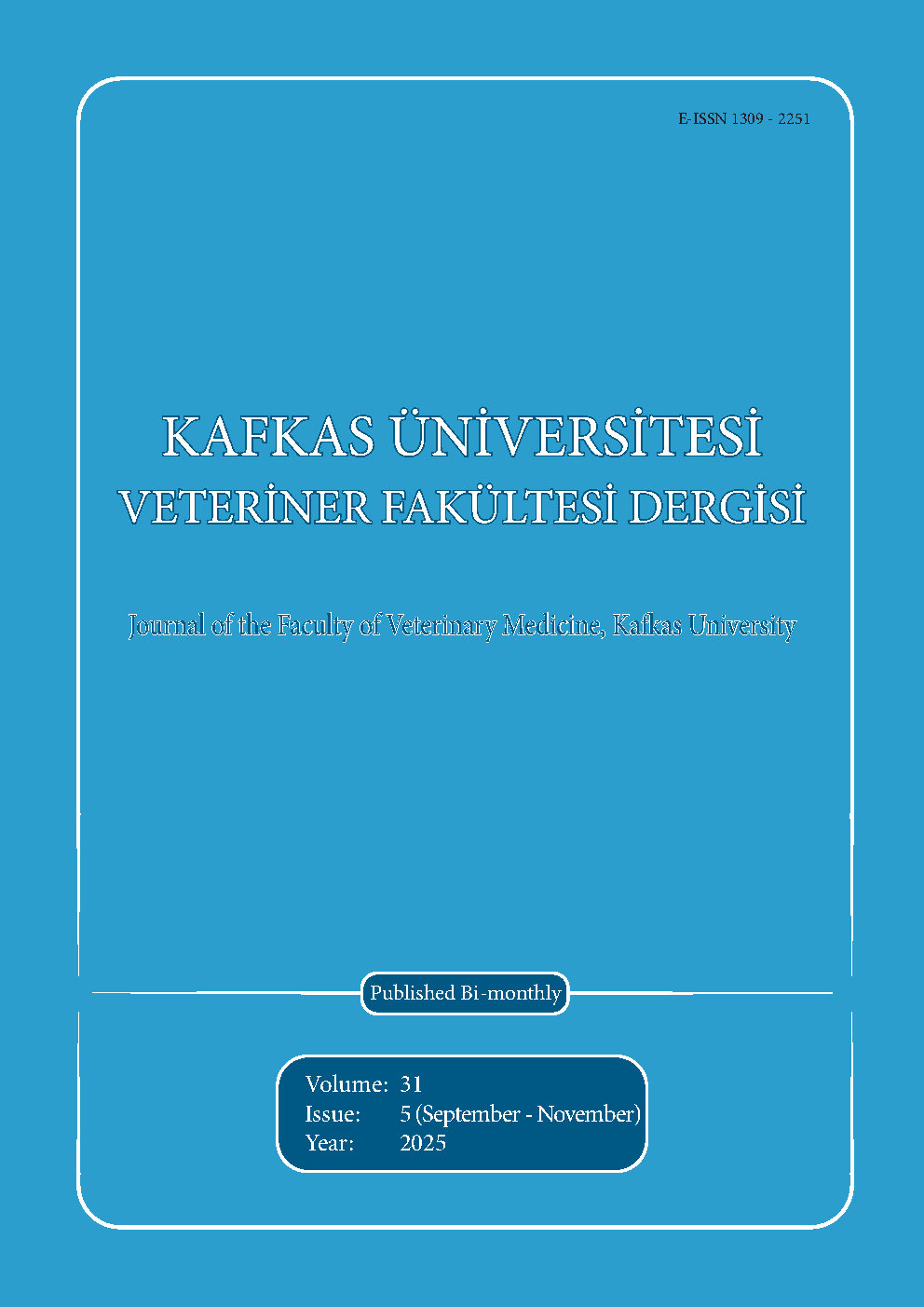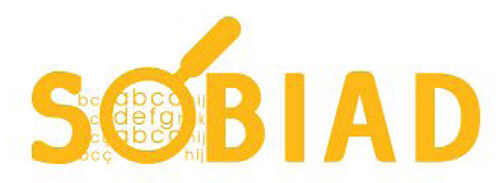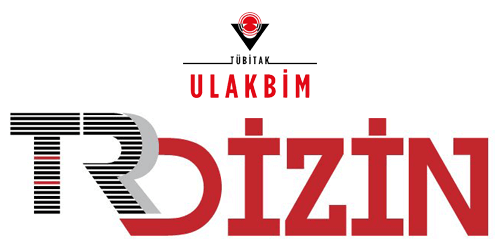
This journal is licensed under a Creative Commons Attribution-NonCommercial 4.0 International License
1- Kafkas Universitesi Veteriner Fakultesi Dergisi (abbreviated title: Kafkas Univ Vet Fak Derg), published bi-monthly (E-ISSN: 1309-2251). We follow a double-blind peer-review process, and therefore the authors should remove their name and any acknowledgment from the manuscript before submission. Author names, affiliations, present/permanent address etc. should be given on the title page only.
The journal publishes full-length research papers, short communications, preliminary scientific reports, case reports, observations, letters to the editor, and reviews. The scope of the journal includes all aspects of veterinary medicine and animal science.
Kafkas Universitesi Veteriner Fakultesi Dergisi is an Open Access journal, which means that all content is freely available without charge to the user or his/her institution. Users are allowed to read, download, copy, distribute, print, search, or link to the full texts of the articles, or use them for any other lawful purpose, without asking prior permission from the publisher or the author. This is in accordance with the BOAI definition of Open Access.
2- The official language of our journal is English.
3- The manuscripts submitted for publication should be prepared in the format of Times New Roman style, font size 12, A4 paper size, 1.5 line spacing, and 2.5 cm margins of all edges. The legend or caption of all illustrations such as figure and table and their appropriate position should be indicated in the text. Refer to tables and figures in the main text by their numbers. Also figure legends explanations should be given at the end of the text.
The figures should be at least 300 dpi resolution.
The manuscript and other files (figure etc.) should be submitted by using online manuscript submission system at the address of Kafkas Universitesi Veteriner Fakultesi Dergisi
During the submission process, the authors should upload the figures of the manuscript to the online manuscript submission system. If the manuscript is accepted for publication, the Copyright Agreement Form signed by all the authors should be sent to the editorial office.
4- The authors should indicate the name of the institute approves the necessary ethical commission report and the serial number of the approval in the material and methods section. If necessary, the editorial board may also request the official document of the ethical commission report. In case reports, a sentence stating that “informed consent” was received from the owner should be added to the main document. If an ethical problem is detected (not reporting project information, lack of ethical committee information, conflict of interest, etc.), the editorial board may reject the manuscript at any stage of the evaluation process.
5- Authors should know and take into account the "Generative Artificial Intelligence (AI)" and other matters listed in the “Ethical Principles and Publication Policy” section regarding scientific research and authors.
6- Types of Manuscripts
Original (full-length) manuscripts are original and proper scientific papers based on sufficient scientific investigations, observations and experiments.
Manuscripts consist of the title, abstract and keywords, introduction, material and methods, results, discussion, and references and it should not exceed 12 pages including text. The number of references should not exceed 50. The page limit does not include tables and illustrations. abstract should contain 200±20 words.
Short communication manuscripts contain recent information and findings in the related topics; however, they are written with insufficient length to be a full-length original article. They should be prepared in the format of full-length original article but the abstract should not exceed 100 words, the reference numbers should not exceed 15 and the length of the text should be no longer than 6 pages in total. The page limit does not include tables and illustrations. Additionally, they should not contain more than 4 figures or tables.
Preliminary scientific reports are a short description of partially completed original research findings at an interpretable level. These should be prepared in the format of full-length original articles. The length of the text should be no longer than 4 pages in total.
Case reports describe rare significant findings encountered in the application, clinic, and laboratory of related fields. The title and abstract of these articles should be written in the format of full-length original articles (but the abstract should not exceed 100 words) and the remaining sections should be followed by the Introduction, Case History, Discussion and References. The reference numbers should not exceed 15 and the length of the text should be no longer than 4 pages in total. The page limit does not include tables and illustrations.
Letters to the editor are short and picture-documented presentations of subjects with scientific or practical benefits or interesting cases. The length of the text should be no longer than 3 pages in total. The page limit includes tables and illustrations.
Reviews are original manuscripts that gather the literature on the current and significant subject along with the commentary and findings of the author on a particular subject (It is essential that the author/s have international scientific publications on this subject). The title and summary of this manuscript should be prepared as described for the full-length original articles and the remaining sections should be followed by introduction, text (with appropriate titles), conclusion, and references.
“Invited review” articles requested from authors who have experience and recognition in international publishing in a particular field are primarily published in our journal.
Review articles submitted to our journal must be prepared in accordance with any of the three categories listed below.
Narrative reviews describe current published information on a scientific topic. However, it does not include a specific methodological process.
Systematic reviews include the search for original studies published in that field on a specific topic, the evaluation of validity, synthesis and interpretation within a systematic methodology.
Meta-analysis is a method of evaluating the results of many studies on a subject with the methods defined in this category and statistical analysis of the obtained findings.
7- The necessary descriptive information (thesis, projects, financial supports, etc.) scripted as an italic font style should be explained below the manuscript title after placing a superscript mark at the end of the title.
8- At least 30% of the references of any submitted manuscript (for all article categories) should include references published in the last five years.
References should be listed with numerical order as they appear in the text and the reference number should be indicated inside the parentheses at the cited text place. References should have the order of surnames and initial letters of the authors, title of the article, title of the journal (original abbreviated title), volume and issue numbers, page numbers and the year of publication and the text formatting should be performed as shown in the example below.
Example: Yang L, Liu B, Yan X, Zhang L, Gao F, Liu Z: Expression of ISG15 in bone marrow during early pregnancy in ewes. Kafkas Univ Vet Fak Derg, 23 (5): 767-772, 2017. DOI: 10.9775/kvfd.2017.17726
If the reference is a book, it should follow surnames and initial letters of the authors, title of the book, edition number, page numbers, name and location of publisher and year of publication. If a chapter in a book with an editor and several authors is used, names of chapter authors, name of chapter, editors, name of the book, edition number, page numbers, name and location of publisher and year of publication and the formatting should be performed as shown in the example below.
Example: Mcllwraith CW: Disease of joints, tendons, ligaments, and related structures. In, Stashak TS (Ed): Adam’s Lameness in Horses. 4th ed., 339-447, Lea and Febiger, Philadelphia, 1988.
Doi number should be added to the end of the reference.
In the references can be reached online only, the web address and connection date should be added at the end of the reference information. The generally accepted scientific writing instructions must comply with the other references. Abbreviations, such as “et al” and “and friends” should not be used in the list of the references.
Follow the link below for EndNote Style of Kafkas Universitesi Veteriner Fakultesi Dergisi;
https://researchsoftware.com/downloads/journal-faculty-veterinary-medicine-kafkas-university
9- Latin expression such as species names of bacteria, virus, parasite, and fungus and anatomical terms should be written in italic character, keeping their original forms.
10- The editorial board has the right to perform necessary modifications and a reduction in the manuscript submitted for publication and to express recommendations to the authors. The manuscripts sent to authors for correction should be returned to the editorial office within a month. After pre-evaluation and agreement of the submitted manuscripts by the editorial board, the article can only be published after the approval of the field editor and referee/s specialized in the particular field.
11- All responsibilities from published articles merely belong to the authors. According to the ethical policy of our journal, plagiarism/self-plagiarism will not be tolerated. All manuscripts received are checking by plagiarism checker software, which compares the content of the manuscript with a broad database of academic publications.
12- The editorship may request the language editing of the manuscript submitted to the journal. If the article is accepted, it will not be published without language editing. Before publication, a declaration and/or certificate stating that proofreading is done by a registered company will be requested from the corresponding author.
13- No fee is charged at any stage in Kafkas Üniversitesi Veteriner Fakültesi Dergisi (No APC/APF)
SUBMISSION CHECKLIST
Please use below list to carry out a final check of your submission before you send it to the journal for review. Ensure that the following items are present in your submission:
- Cover Letter
- Importance and acceptability of the submitted work for the journal have been discussed (Please avoid repeating information that is already present in the abstract and introduction).
- Other information has been added that should be known by the editorial board (e.g.; the manuscript or any part of it has not been published previously or is not under consideration for publication elsewhere.
- Title Page
- Title, Running Title (should be a brief version of the title of your paper, no exceed 50 characters)
- The author’s name, institutional affiliation, Open Researcher and Contributor ID (ORCID)
- Congress-symposium, project, thesis etc. information of the manuscript (if any)
- Corresponding author’s address, phone, fax, and e-mail information
- Manuscript
- Title, abstract, keywords and main text
- All figures (include relevant captions)
- All tables (including titles, description, footnotes)
- Ensure all figure and table citations in the text match the files provided
- Declarations
- Availability of Data and Materials
- Acknowledgements
- Funding Support
- Competing Interests
- Generative Artificial Intelligence (AI)
- Authors’ Contributions
Further Considerations
- Journal policies detailed in this guide have been reviewed
- The manuscript has been “spell checked” and “grammar checked”
- Relevant declarations of interest have been made
- Statement of Author Contributions added to the text
- Acknowledgment and conflicts of interest statement provided










